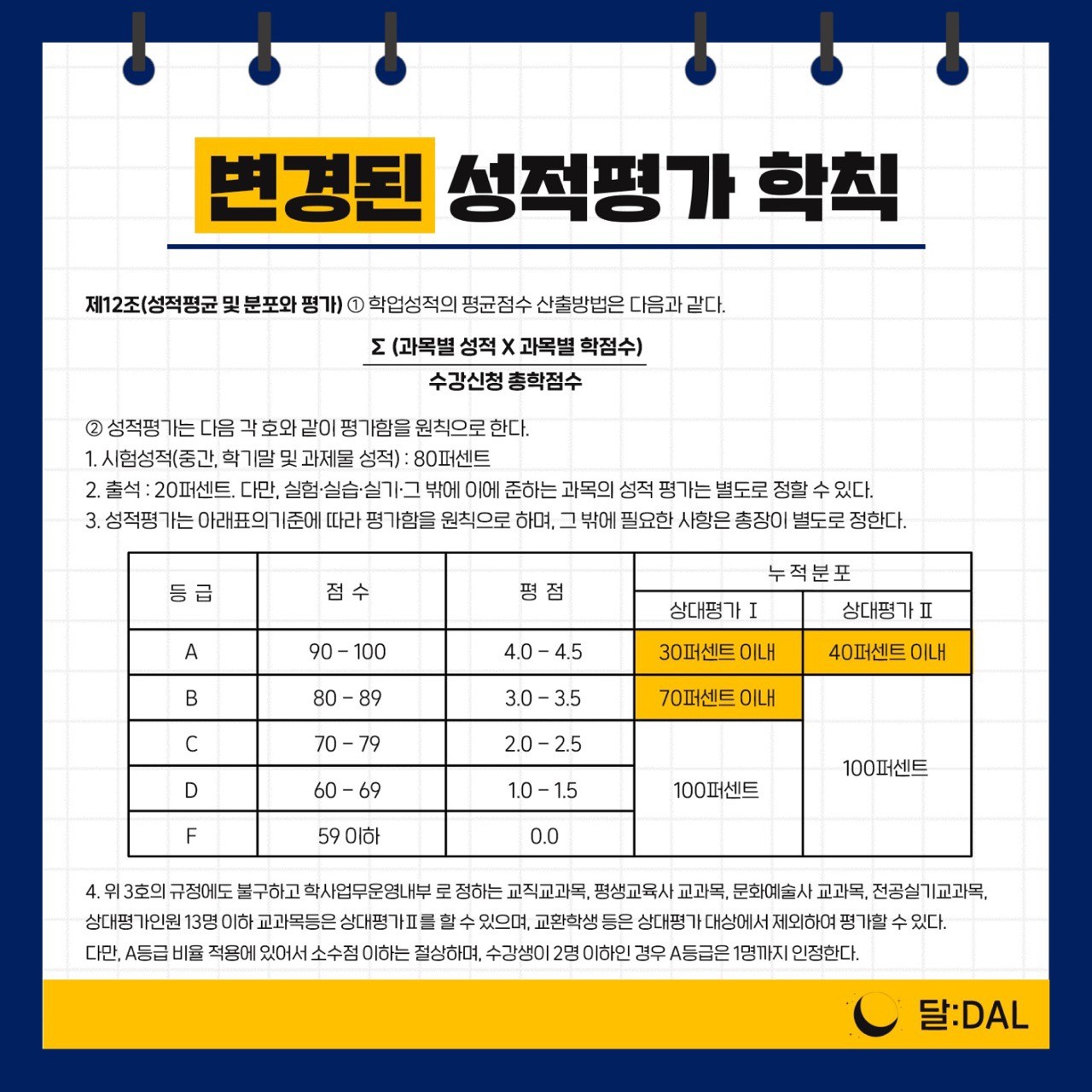On December 9, an article related to evaluation methods was posted on ‘Every Time,’ a community application where Dankookians (Students of Dankook University) can access school life information. Through the card news, the student council presented the components of the existing Dankook University (DKU)'s grading system and explained how the ratio of the grade distribution will change. The report said, the ratio of grade evaluation will be eased beginning in the first semester of 2021. They described the change as an achievement accomplished by combining the efforts of the student council and the voices of Dankookians. Nowadays, a student’s grade point average (GPA) is an important indicator used as an evaluation element in the recruitment process of most companies. However, it is difficult for some students to get higher GPAs than their competitors because each school provides different grade evaluation schemes. Universities are easing the percentage of evaluations to increase student chances of employment. This process is known as “Grade Inflation.”
 |
| ▲ Card News about Existing GPA System (Photo from Everytime) |
As DKU had a lower percentage of A to B credits as compared to other universities, Dankookians expressed discontent with the policy, posting comments on anonymous communities such as Dankookie and Every Time or by posting questions and suggestions to the 달: DAL Student Council to take up the matter on their behalf. Accordingly, since the first semester of 2020, the student council persistently put forth requests to DKU to evaluate the existing grade curve ratio and by the end of the academic year, the school finally relinquished its position and accepted the proposal. The new grading regulations will come into effect the first semester of this year.
 |
| ▲ Card News about Changes to GPA System (Photo from Everytime) |
'Academyinfo' is a website where we can easily and conveniently find information about different universities. We compared the performance evaluation system of Dankook University to that of other universities through Academyinfo. According to the site, the average set of A ratios in domestic universities is at 30-35 percent, with some universities allowing up to 40 percent. Kyung Hee University has a 35 percent A grade and 70 percent cumulative ratio including Bs in their relative evaluation classes. This was about 10 percent more than was offered at Dankook University. Next, we looked at Inha University’s GPA system. They eased the criteria for granting credits as of the second semester of 2019. Students responded positively to the changes. Based on Inha University's relative evaluation scheme, classes of more than 20 students has a grade distribution of 35 percent As and 45 percent Bs, with the rest C, D, and F. The subjects of experiment, practice, and major concentration of fewer than 20 students has a 40 percent A grade distribution, 50 percent Bs and the rest C, D, and F. This is also about 10% more than Dankook University's existing cumulative grade distribution plans. The data shows that Dankook University's performance evaluation system has been disadvantageous as compared to other schools. To find out how Dankookians felt about the 2021 grade curve changes, the Dankook Herald (DKH) conducted a public opinion survey. Of the total respondents, 61.5% were aware of the new performance ratio changes. The DKH asked if they were satisfied with the new rate criterion. Most appeared positive about the changes. A majority responded "satisfied", followed by 15.4% with "very satisfied", while others chose "indifferent". They expressed concerns about their competitiveness in the job market due to lower GPAs as compared to other schools as the main reason they were in favor of easing their grade curve rates. Another Dankookian said, ”Under the existing system, the ratio of A grades was so low, it was regrettable that your grades sometimes fell due to subtle differences in scores.” Next, the DKH asked whether they thought the ratio of grades should be different in special situations caused by disasters such as Covid-19. Many Dankookians said yes. They argued that the absolute evaluation method was appropriate based on the fact that "the learning environment varies greatly among students" and "it is difficult to evaluate fairly in such situations." Finally, the DKH asked what Dankookians wanted to change the most in the DKU learning environment system, apart from the grade-ratio, and why. The most-popular suggestion was the limited number of class applicants. One Dankookian said, "Even in major classes, sometimes I cannot take the ones that I want to take because of limitations on the number of applicants. There are only a few extra seats available, so it's hard to take classes that fit into my original plans.' In addition, there were opinions on the quality of lectures and improving the learning environment for hearing-impaired students. The existing evaluation method saw 25 percent of the class earning As, 35 percent Bs and the rest C, D and F. In the case of special evaluation classes, the A ratio was 30 percent and the rest was 70 percent. The new system will see the class grade distribution change to 30 percent As, 40 percent Bs and 30 percent C, D, and F. In addition, the special evaluation class has increased the number of possible. As by 10 percent to 40 percent with B, C, D and F accounting for the remaining 60 percent of students.
The reorganization of the grade evaluation system is expected to have a positive impact on Dankookians as it will raise the likelihood of earning better GPAs, which directly impact student recruitment in the job hiring process of most companies. The 달: DAL Student Council has tried to mitigate problems related to the grade curve ratios, which was less than that of other schools, and has succeeded by gathering the support of impacted students. Therefore, it is important for students to remain interested in policies that will improve the learning environment. Together we can build a stronger institution for ourselves and for future Dankookians.
권유지, 김건희, 류시은 dankookherald@gmail.com

![[Campus Magnifier] Let's Surf the Library!](/news/photo/202404/12496_1765_4143.jpg) [Campus Magnifier] Let's Surf the Library!
[Campus Magnifier] Let's Surf the Library!
![[Campus Magnifier] Let's Surf the Library!](/news/thumbnail/202404/12496_1765_4143_v150.jpg)





